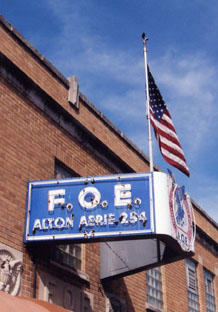For about ten years, I've been photographing places and things that retain the strong stylistic flavor of a colorful and distinctive period in the annals of design, architecture and signage. From the bold, heroic forms and confident Streamline Moderne curves of the Public Works Administration and the post-Depression recovery period to the futuristic fantasies of the Space Age to the programmatic whimsies and carefree dayglo color splashes of the Beatle era.
Why? This is the way America looked when I first saw it as I was growing up. The colorful jumble of every city's neon-laced commercial strip was about to be muted by more stringent signage codes and a muted, earth-toned sensibility that would eventually slap a dull, shake-shingled mansard roof over the gleaming candy-striped tile and glowing golden arches that had helped make the suburbs seem somehow exciting.
In the days before Everytown's fast-food-and-motel strip was dulled down by a beautification movement spearheaded by a President's wife, the commercial landscape was chaotic. When one sees a 1960's photograph of a typical "miracle mile," it's almost always shot with a lens that flattens the perspective, making the jumble of signs into a panicky collage of overstimulation--No one at the time took a picture of Fast Food Row because they thought it looked "cool;" such a photo was always created and used as an example of how how ugly and out-of-control things had become. Fair enough; there was certainly plenty of truth to that viewpoint. But today, when a vintage photo of that type is displayed, many of us find ourselves squinting to catch the details; the little things we remember from our youth but haven't seen in years. Is that an old Jack-in-the-Box sign, with the clown head bobbling on a spring? Wasn't the old Holiday Inn sign magnificent? Oh, wow, do you remember Arthur Treacher's...or Carrol's...or that huge neon Katz Drug cat with the bow tie, the one that scared the hell out of you when you were four? (Okay, that's just me. But by the time I've dug all the evidence out of my archives and posted it here, that damn cat will give you the willies too.)
A friend told me that nostalgia literally means "past-pain." We took things for granted back then, and we miss them now; we fear that someday they'll all be gone. It could be argued that a single blinking, buzzing Edsel-era neon sign remaining among a forest of tasteful, backlit logos on the highway strip is more striking and more beautiful than it was when
everybody's sign blinked and buzzed just so.
Along with a growing legion of mid-century dreamers, I'm out there every chance I get, looking for that last neon beacon. If this sort of nostalgia trip seems like
your cup of Postum, you should check out the
Society for Commercial Archaeology and the list of links I'll be posting and most likely adding to frequently. And there will, of course, be photos. Lots of 'em.
 Ashley is now so insignificant that the Rand McNally Road Atlas doesn't even list its population; other sources place the year-2000 figure at anything from 600 to 1500. But Ashley was obviously more important at one time--How else to explain all the motels? Before the Interstates came through (a major interchange is less than 15 miles away at Mt. Vernon), Ashley was sitting pretty at the intersection of US 51 (a major north-south route) and State Road 15. This placed it just about halfway across the state for east-west travelers, and thus a natural stopping point.
Ashley is now so insignificant that the Rand McNally Road Atlas doesn't even list its population; other sources place the year-2000 figure at anything from 600 to 1500. But Ashley was obviously more important at one time--How else to explain all the motels? Before the Interstates came through (a major interchange is less than 15 miles away at Mt. Vernon), Ashley was sitting pretty at the intersection of US 51 (a major north-south route) and State Road 15. This placed it just about halfway across the state for east-west travelers, and thus a natural stopping point.












